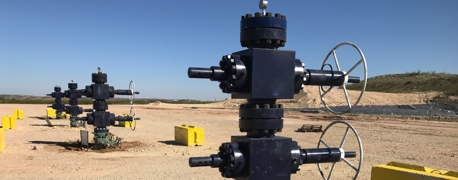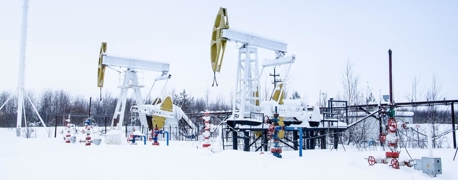What Is a Mud Engineer?

The more formal name for this job is “drilling fluids engineer”, but colloquially, drilling fluid is known as "mud". A mud engineer, or more simply, a mud man, is responsible for make sure that drilling fluid has the exact composition needed to keep the drill moving efficiently while staying clean and cool, and that as the drill goes deeper to different soil layers, the fluid is adjusted as needed. Another reason the drilling fluid needs to be constantly monitored is to ensure that it’s always providing enough pressure. Worst case scenario, improperly mixed drilling fluid can lead to a blowout.
The stakes are high, and it takes years of training and experience to meet the qualifications for becoming a mud engineer. It’s a critical role for both inland and offshore drilling, and just as with any job in the oil industry, it’s not for the faint of heart. This high-pressure position comes with serious safety and health risks, and if the oil companies involved are looking for opportunities to cut costs rather than operate safely, the mud engineer could be one of the first roles in the line of fire.
What Does It Take to Be a Mud Engineer?
You usually need an engineering degree, and a focus on chemical, mineral, or mining engineering can be particularly helpful. There are even schools that offer training specific to drilling fluid technology. It is possible to start with a high school diploma to work with a mud engineer, then gain years of experience on the job, working your way up to the mud engineer position. After years as say, a drilling assistant, it is possible to get the role if you can prove sufficient expertise in math, physics, geology, chemistry, IT, and so forth.
When it comes to being qualified for offshore work in particular, there will be further required training.
Mud engineers can also be required to complete additional training for:
- Firefighting
- Water survival
- Helicopter underwater escape training (HUET)
- Basic offshore safety induction and emergency training (BOSIET) for emergency first aid, lifeboat use, etc.
- Minimum industry standard training (MIST) for navigating hazardous chemicals and liquids
- Competency in Ex atmospheres (CompEx), the “Ex” meaning “explosive”
Mud engineers must also have medical certificates that establish they’re physically fit enough for the job, and other certificates and training beyond these could be required.
What Does a Mud Engineer Do?
When it’s time to drill, a mud engineer is onsite to mix the drilling fluid, monitor and measure it as drilling progresses, and decide when and how to adjust the mud mix. There’s a lot that goes into this process, and the mud engineer should also have the expertise to recommend drill bits for each job as well as help technicians with the actual drilling.
The mud is fed through a mud mixing hopper and eventually is pumped down the drill pipe where it helps clear away cuttings (rock debris), applies pressure to keep the hole open, and lubricates, cleans, and cools the drill. The drilling fluid then travels back up through the empty space between the drill pipe and outer piping (an area called the annulus) and out an exit, where the cuttings are sifted from the mud, so that the drilling fluid can be sent back down the pipe. Without this drilling fluid creating pressure and carrying away cuttings, the pressure from the surrounding layers of rock and soil would simply cause the hole to collapse or keep refilling, which would ensure that the drill never makes headway.
After a job is safely done, the mud engineer will also need to know how to dispose of the waste created, that is, the fluids and mud made. They have to do so without causing environmental devastation. It takes technological expertise to perform all required maintenance and cleaning of the drill and related systems.
Mixing the Drilling Mud
As the mud engineer mixes, measures, and adjusts the mud, they need to assess its viscosity, density, weight, pH, salinity, and many other characteristics to make sure that the chemicals and fluid in the mix are balanced.
Drilling fluids are typically:
- Water based,
- Oil based, or
- Synthetic based.
Whatever the project and whatever the base, the mud engineer has to put in the right amount of certain additives. This requires not only significant expertise in the different properties required of drilling fluid, but also continual research into the soils involved along with other geological information. Once the mud is at a safe, effective balance for one layer of drilling, this won’t be adequate as the drill bores deeper, so the engineer will have to continually assess the mud and geological readings in order to keep getting the mud mixture right.
If the mud doesn’t exert enough pressure, natural gas, oil, and drilling fluid can surface, which can lead to a well spill and fires, harming people and the surrounding wildlife and environment. However, if the mud is too heavy or exerts too much pressure, then this can ruin the drill, burning millions of dollars in lost drilling time and equipment replacement. If the mud engineer fails at their job, whether through being given faulty information or inadequate equipment from the company, then not only does the drilling not work, but it can also get people killed.
Who Does a Mud Engineer Work With?
Mud logger is not a role that’s interchangeable with that of mud engineer. The two positions will be people working for different companies, such as a mud logging company and a mud company, respectively. While the mud engineer is responsible for making sure the drill has the mud it needs to work efficiently, the mud logger is checking the formation the drill makes and assessing how things are going, such as by monitoring the cuttings and gases being sent back up from the hole. This is more of a geology-focused role, while the mud engineer is more of a chemistry-focused role. The mud logger’s assessments are a factor in a mud engineer’s strategy for adjusting the drilling fluid.
The derrickman has many duties that can include implementing the mud engineer’s prescribed mixture and adjustments for the drilling fluid, as well as collecting samples for the engineer to measure. Roughnecks put the pipes together and collect cuttings and so forth.
These are just a few of the positions that will also share in the risks brought by working with heavy equipment and around hazardous, flammable substances.
What Risks Do Mud Engineers Face?
The occupational risks for mud engineers start before they even arrive on site. According to the CDC, between 2014 and 2019, the majority of fatalities in the oil and gas industry were due to transportation, and that was true whether workers arrived by vehicle to on-land rigs or were traveling by watercraft or helicopter to an offshore rig.
The data also found that 14% of fatalities in the industry occurred during drilling operations, cementing the mud engineer’s role as one that occurs in a particularly hazardous point in an already dangerous field. A significant number of these deaths were cardiac events. An additional 11.3% of deaths were preceded by working with drilling fluids.
Toxic Exposure in Mud Engineering
There is the daily risk that comes from exposure to toxic substances, from the chemicals and fluids that mud engineers work with, to crude oil, diesel, lubricants, hydraulic oils, and more. There’s not only the risk of physical contact, but also of inhalation.
When these substances are inhaled, these can cause:
- Neurological injuries
- Cancer
- Lung damage
- Blood disorders
Adequate personal protective equipment (PPE) is critical, as are safety procedures. If PPE isn’t cleaned off properly after a shift, laundry detergent won’t be enough to take care of many of these substances. For instance, many types of drilling fluid can’t be washed away by detergent, potentially exposing everyone from laundry service to drilling teams to hazardous chemicals.
Equipment Risks for Mud Engineers
Because mud engineers work with and around heavy equipment, they’re at risk for caught-between and struck-by accidents, lifting injuries, and more. As they often need to climb steep stairs or ladders, that also means they face fall risks. These and similar occupational hazards can be catastrophic and even deadly, leading to traumatic brain injuries, amputations, crush injuries, spinal cord damage, and more.
Blowouts & Fires
Some of the most severe dangers that mud engineers face, and ones that they’re tasked with mitigating for the whole crew, are the risks of blowouts, fires, and explosions. These are very real risks when substances like natural gas escape from the hole being drilled, escaping to an atmosphere where there are numerous ignition sources, from welding tools and electricity to frictional heat and more. There are also many flammable chemicals to feed any blaze that shoots up from the well onto the rig.
These dangers can result in life-changing or life-threatening:
- Burn injuries
- Amputations
- Shrapnel wounds
- Fractures
- Disfigurement
- Brain trauma
- And more
Unfortunately, blowouts, explosions, and fires still occur even when a mud engineer does everything right. That’s because they also have to depend on the information, equipment, and other resources from companies that too often have proven negligent or even reckless.
Difficult Working Conditions
All these dangers are exacerbated by extremes in weather, as any oilfield is going to be remote. Whether that means working on land in a punishing desert or frigid tundra, or working offshore with highly changeable weather, severe temperatures and unpredictable conditions can make even simple tasks hazardous.
This makes any job more physically demanding, and this in a field where 12-hour workdays are normal. These long hours are often expected to last for weeks or months on end, no weekends or holidays off. Just like any other oil rig worker, mud engineers might work 14 to 28 days in a row, then take as many days off before starting another stretch of work. This can take a physical and mental toll on anyone, which can also heighten the risk of accidents.
Who Is at Fault for a Well Blowout?
It’s an important point to reiterate. If there’s a well blowout, this does not automatically mean that a mud engineer failed at their job. To be sure, human error can be a cause for these disasters, but that human error has to come from multiple sources. Well blowouts are almost never the fault of just a handful of people, and there are entire teams working on any oil rig, feeling the urgency of company deadlines and the pressure to not waste any time or expenses.
Sometimes, there may simply have been geologic conditions that nobody could have planned for. Usually speaking though, blowouts and how to prevent them are well-documented at this point.
If there’s a devastating blowout, it’s probably because the company or companies involved failed to plan for these obvious dangers.
If an individual gets blamed at any point for a disaster of this magnitude, it’s often the result of companies picking a scapegoat to pin the blame on in order to avoid scrutiny for their cost-cutting.
The Deepwater Horizon Blowout
The most notorious example of a well blowout, the Deepwater Horizon disaster, is a prime example of this. BP was blamed for “reckless” actions (which was worse than the negligence for which Transocean and Halliburton were faulted). These companies, and not any individuals, were ultimately blamed for putting profits above safety when drilling.
One of the key factors was BP’s faulty blowout preventer that failed to do its job in sealing the well. The failed blowout preventer hadn’t been inspected since 2005, five years before the disaster, and it was very overdue for maintenance. Leading up to the well blowout, BP was working at a frenzied pace because they were already over budget by tens of millions of dollars, behind schedule by weeks, and they were willing to ruthlessly cut corners to make up for it.
Mud & Oil Companies Owe Mud Engineers Safe Working Conditions
The sad reality is that a drilling fluids engineer and the crew working with them could do everything correctly, but if upper management has made cost-cutting decisions, left workers with defective safety equipment and faulty drilling equipment, or there was a bad well or rig design, it’s the drilling team that can pay the costly price.
The mud engineer plays a vital role in the effectiveness and safety of drilling operations, but if a company fails in its responsibility to provide workers with everything they need to work safely, there’s only so much one person can do.
- Categories


